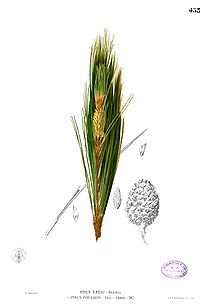Pinus kesiya
| Pinus kesiya | |
|---|---|

| |

| |
| Benguet pine in Benguet, Philippines | |
| Scientific classification | |
| Kingdom: | Plantae |
| Clade: | Tracheophytes |
| Clade: | Gymnospermae |
| Division: | Pinophyta |
| Class: | Pinopsida |
| Order: | Pinales |
| Family: | Pinaceae |
| Genus: | Pinus |
| Subgenus: | P. subg. Pinus
|
| Section: | P. sect. Pinus
|
| Subsection: | P. subsect. Pinus
|
| Species: | P. kesiya
|
| Binomial name | |
| Pinus kesiya | |
Pinus kesiya (Khasi pine, Benguet pine or three-needled pine) is one of the most widely distributed
The common name "Khasi pine" is from the Khasi hills in India, and "Benguet pine" is from the landlocked province of Benguet in Luzon, Philippines, where it is the dominant species of the Luzon tropical pine forests (known as saleng in Ilocano[4]). The Benguet pine is sometimes treated as a separate species, Pinus insularis; however, the current opinion is to treat these as conspecific with P. kesiya. The city of Baguio is nicknamed "The City of Pines", as it is noted for large stands of this tree.
Description

Pinus kesiya is a
Khasi pine usually grows in pure stands or mixed with broad-leaved trees, but does not form open pine forests.[citation needed]
Uses
The soft and light
The good-quality resin is not abundant and has not been much used except during the Spanish colonial period in the Philippines for the production of turpentine.[5]
See also
- Casuarina equisetifolia, the agoho pine
References
- . Retrieved 19 November 2021.
- ^ ISBN 1-872291-64-3. Archived from the originalon 2007-05-19.
- ^ a b "Pinus kesiya". AgroForestryTree Database. International Centre for Research in Agroforestry. Retrieved 17 April 2012.
- .
- )
External links
- Gymnosperm Database: Pinus kesiya
- Suitability of Pinus kesiya for tree-ring analyses
- "Luzon Tropical Forests". Terrestrial Ecoregions. World Wildlife Fund.

